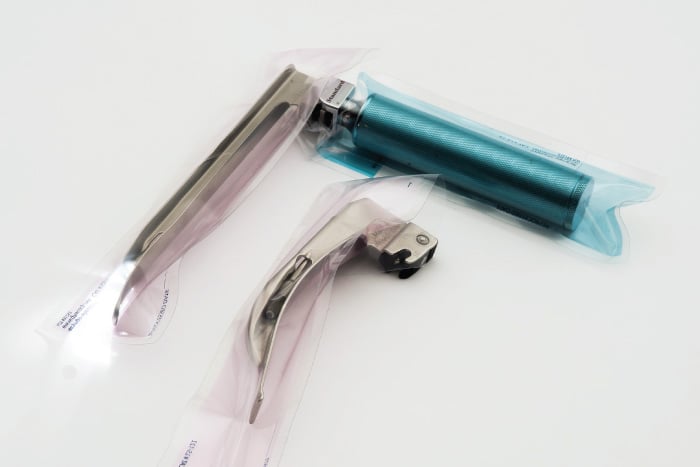The following example of a revised protocol for reprocessing and packaging laryngoscope blades and handles was shared so that it could help others who are considering new protocols for their facility. The healthcare system name has been removed by request.
==========================================================================
Subject: Cleaning, High Level Disinfection, and Packaging of Laryngoscope Blades and Handles
Applicability:
- All (identity removed) Health Care System Sites
- Policy:
After use, all laryngoscope blades and handles will be processed in CSP to include cleaning, disinfecting, testing, and packaging in a manner that ascertains the blade/handle to be ready for immediate use.
Protocol
- Procedure: Cleaning and High Level Disinfection Procedure for Blades:
Point of Use:
- Separate blade from handle and spray with neutral pH enzymatic pre-cleaner or wrap in moist, quaternary ammonium isopropanol based germicidal wipe. Return to CSR for subsequent cleaning and reprocessing.
Subsequent Cleaning:
- Remove blade from handle before cleaning. Tighten bulbs before cleaning.
- Rinse blade under cool running tap water until all visible soil is removed.
- Immerse the blade in an enzymatic detergent and scrub thoroughly using a soft bristle brush until all visible soil is removed. (Enzymatic detergent is prepared in accordance with enzymatic cleaner manufacturer’s recommendations)
- Remove and rinse under cool running tap water to remove all residual detergent
- Dry blade with lint free, clean cloth
High Level Disinfection
- Place cleaned blades in, hospital approved, high–level disinfectant solution that is prepared and maintained according to manufacturer’s recommendation.
- Set the timer for 8 minutes per manufactures recommendations to allow for blade exposure. Blades should be removed immediately following the 8 minutes.
- Thoroughly rinse blades by fully immersing in potable water.
- Blades should then be thoroughly dried with lint free, clean cloth
- Making sure that lightbulb is fixed securely in blade; test the light bulb for functionality by attaching blade to the laryngoscope handle. If the light from the bulb is dull or does not wok it should be replaced with a new bulb and retested.
- Blades must be placed in a laryngoscope blade sleeve. A clean sticker should be attached to the sleeve to hold the tab on the sleeve cover closed. Blade sleeve covers should be used for all laryngoscope blades processed by the CS Department
- Blades belonging to surgery, OB and/or CSP must be separated so that they can be returned to the appropriate department.
- Cleaning and Intermediate Level Disinfection for Laryngoscope Handles:
Point of Use:
- Separate the blade from the handle and wrap handle in moist, quaternary ammonium isopropanol based germicidal wipe to prevent drying
Subsequent Cleaning and Intermediate level disinfection:
- Using a quaternary ammonium isopropanol based germicidal wipe, clean all exposed surfaces of the handle and end cap
- If necessary, brush with a dry, soft-bristled brush and re-wipe to loosen/remove excessive visible soil
- After all soil is removed, using a new wipe, re-wipe exposed surfaces of the handle and end cap and allow adequate contact time for disinfection as directed by germicidal wipe manufacturer
- Handles are to be placed in the laryngoscope handle coverwith the connecting in facing up. A clean sticker should be placed on the sleeve to hold the sleeve tab down.
- Handle sleeve covers are to be used for all laryngoscope handles processed in the CS Department.
- Testing:
- All laryngoscope blades and handles are to be tested prior to being returned to customers, being put in intubation boxes,and/or being placed on code carts. Corrective action, (replace batteries/bulbs) needs to be taken if blades/handles fail testing
- Retest blade/handle once corrective action has been completed. If testing fails, blade/handles should be removed from service and given to CSP Manager for action.


